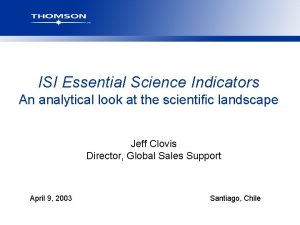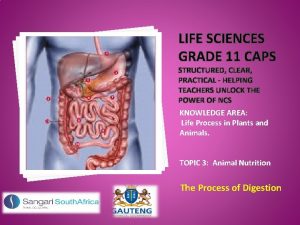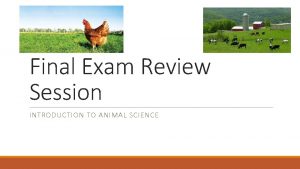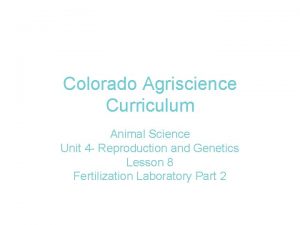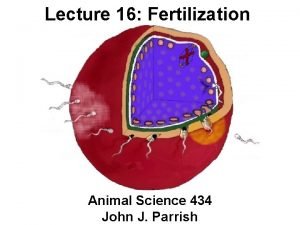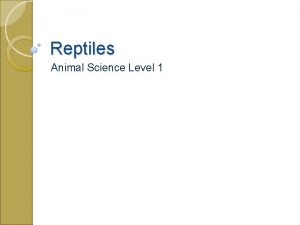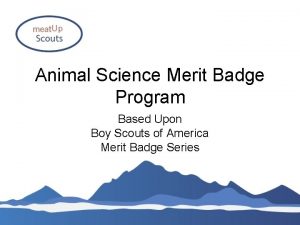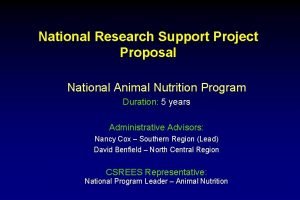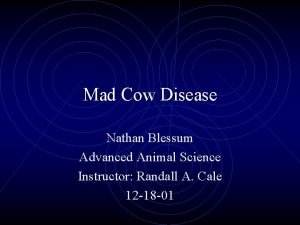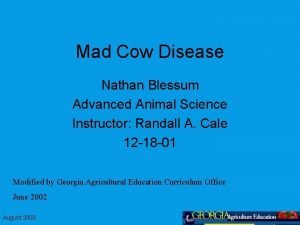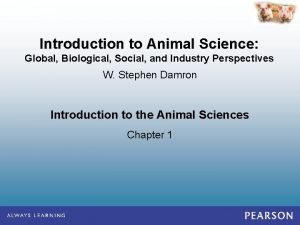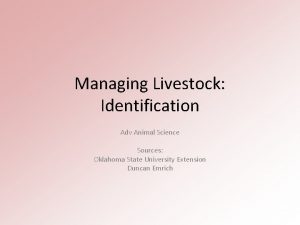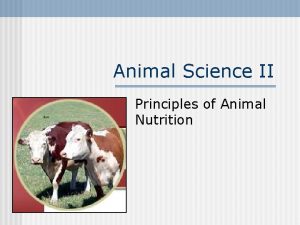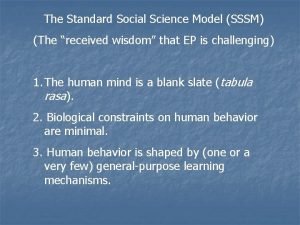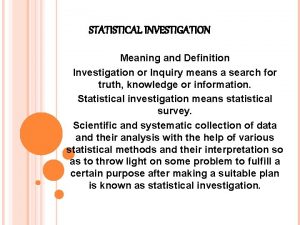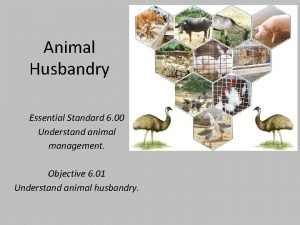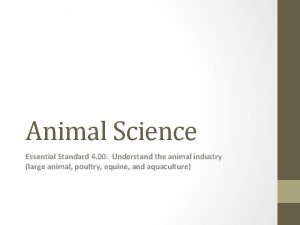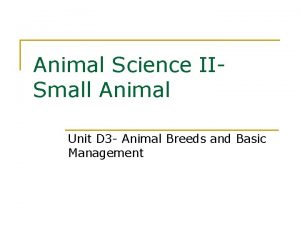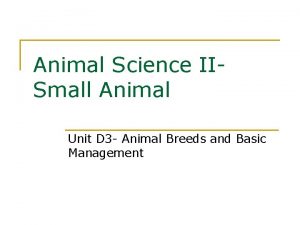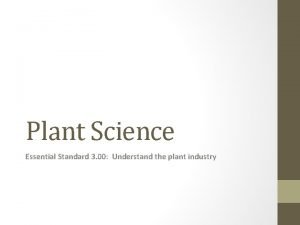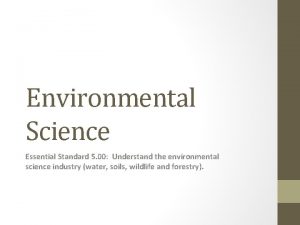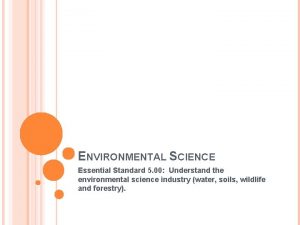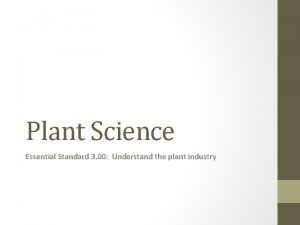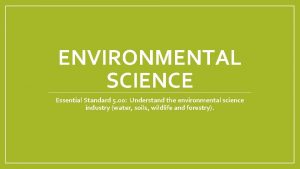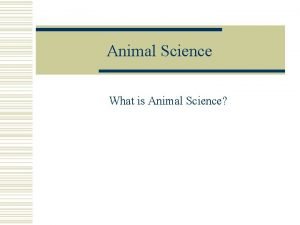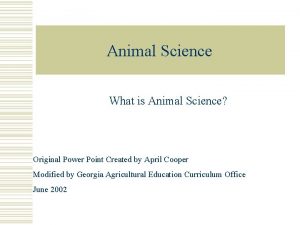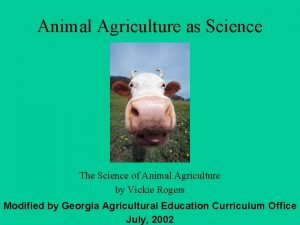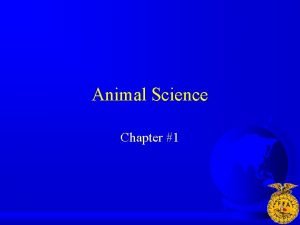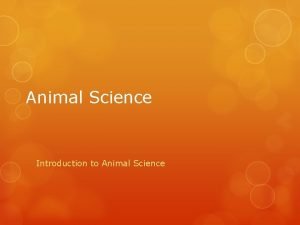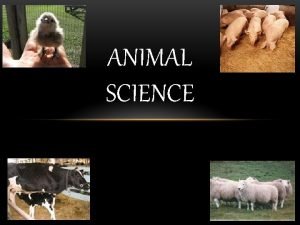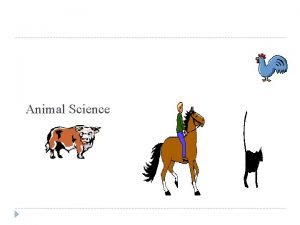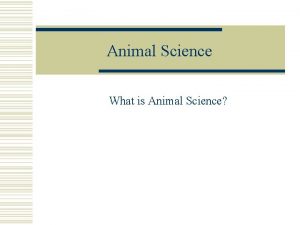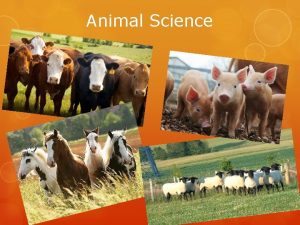Animal Science Essential Standard 4 00 Understand the




























































































- Slides: 92

Animal Science Essential Standard 4. 00: Understand the animal industry (large animal, poultry, equine, and aquaculture)

Objective 4. 01 • Remember careers in the animal industry.

Major Animal Science Industries: • Large animal (livestock) • Defined: Farm animals raised to produce milk, meat, work and wool. • Examples: Cattle, sheep, swine, goats • Poultry • Defined: Any or all domesticated fowls that are raised primarily for their meat, eggs or feathers. • Examples: chickens, turkeys, ducks, geese

Major Animal Science Industries: • Equine • Defined: Horses or other members of the family Equidae. • Examples: Horses, mules • Aquaculture • Defined: Underwater agriculture, commonly called fish farming. Also includes the growing of water vegetation such as kelp. • Examples: Tilapia, trout, catfish, shrimp

Examples of animal science careers • • Animal nutritionist – one who studies nutrient values of feeds, including how digestible they are. Veterinarian – an animal doctor. Geneticist – a person who studies and applies genetics. Animal Technician– one who cares for and manages animals in a variety of settings including animal hospitals.

Examples of animal science careers • • Farm/Herd Manager – manages the daily operation of a livestock farm. Horse Breeder/Trainer – breeders are in charge of the record keeping and scheduling involved with being a breeder. Farrier –a person who shoes horses. Veterinary Technician– assists the veterinarian in caring for animals.

Examples of animal science careers • • Butcher - a person who slaughters animals or dresses meat. Meat Inspector – a trained individual employed by regulatory authorities to inspect all meats as they pass through a slaughter facility or packing plant. Artificial breeding Technician – a person certified to artificially breed livestock. Sales representative, Animal Health Products – a person who sells animal health products to veterinarians and stores that sell these products.

USDA Meat Inspector

Examples of animal science careers • • Poultry Hatchery Manager – a person who manages the daily operation of a hatchery facility. Equine Dentist – specialized dentist who works on horses. Equine Magazine Writer – a person write articles about the horses and the horse industry. Microbiologist – a scientist concerned with the study of plant and animal microorganisms.

Objective 4. 02 • Understand biotechnology in the animal industry.

Biotechnology in the Animal Science Industry • Animal cloning • For product uniformity • drumstick uniformity in the poultry industry • Saving endangered species • New animals could be reproduced from the tissue of remaining animals • Research purposes • Genetically identical animals are better for research studies that try to isolate one variable


Biotechnology in the Animal Science Industry • Biotechnology in Animal Reproduction and Production • BST (Bovine somatotropin) • A hormone produced in the pituitary gland of cattle • increases milk production • Method of gene splicing genetic material into E. coli bacteria • Produced at relatively low cost • Dairy cows given BST will produce more milk

Biotechnology in the Animal Science Industry • Biotechnology in Animal Reproduction and Production • Artificial Insemination (AI) • Process involves the introduction of the male sperm into the reproductive tract of a female • By means other than the natural mating process • Most of the cows in the dairy industry are produced through AI

Biotechnology in the Animal Science Industry • Biotechnology in Animal Reproduction and Production • Embryo Transfer • Transferring of embryos from one female to another • One female can produce many calves in a year due to superovulation • donor animal to release several eggs instead of just one • A superior female can be fertilized by genetics from a superior male • resulting embryos implanted into inferior female animals

Objective 4. 03 • Understand basic animal principles and practices.

Dairy Industry • Breeds • Holstein • black and white markings • produces the most milk • Ninety percent of dairy cattle in the US • Jersey • smallest dairy breed • second most popular breed • number one rank in butterfat • Guernsey • Fawn and white • Ayrshire • Cherry red and white

Beef Industry • Predominant English breeds in the U. S. • Angus • black color • known for excellent meat quality • Hereford • both horned and polled • red cattle with a white face

Beef Industry • Exotic breeds • Imported into the U. S. when consumers began demanding leaner meat • Grow faster than English breeds

Beef Industry • American breeds • developed to withstand heat • resistance to disease and parasites • Resulted from crossing Brahman cattle from India with English breeds • increased heat tolerance and disease and parasite resistance of Brahman and the meat quality of the English breeds • Example: Brangus • result of Brahman x Angus.



Swine Industry • Changed greatly from the lard type hogs of the past to the lean type hogs • Types of swine operations: • Feeder –pig producers • Market –hog producers • Farrow to Finish producers



The Result!

Swine Industry • Purebred producers produce high-quality boars • Improves the genetic make-up of one breed of swine • Purebred boars bred to crossbred sows increase hybrid vigor (ex. muscling). • Duroc, Hampshire and Yorkshire are the most popular U. S. purebred breeds today

American Landrace

Duroc

Hampshire

Yorkshire

Poland China

Chester White

Tamworth

Berkshire

Spotted Swine

Poultry Industry • Classified as layers or broilers • Broilers are young chickens grown for their meat • Trace their ancestors back to the Cornish breed • Layers are chickens developed to produce large numbers of eggs • White leghorn –foundation breed

Poultry Industry • Breeds • White Leghorn (layer) • white bodied with red combs • Broiler and layer types used in industry today result from crossbreeding • Turkeys • 90% of commercially raised turkeys are the Broad-Breasted White

Broiler

White Leghorns

Barred Rock

Rhode Island Red

Equine Industry • Uses • Show • Racing • Recreation • pleasure riding, rodeo, draft horses, etc. • Breeds (3 most popular) • Quarter horse – riding, hunting, and working cattle • Thoroughbred • Arabian

Aquaculture Industry • Water Quality • The key/challenge • Dissolved oxygen (DO) levels in any fish system can become so low that fish die • Measured by oxygen probes or chemical tests and reported as 0 -10 ppm • Most fish can survive as low as 3 parts per million • become stressed and succumb to other problems • Rainbow trout • Require high levels of DO • Can only be cultured in oxygen –saturated water • Aerators are used to improved oxygen levels

Aquaculture Industry • p. H • measurement of acidity or alkalinity in water • affects the toxicity of soluble nutrients in the water • Measured using a meter or litmus paper • The scale is 0 -14 • Neutral is 7 • Below 7 is acidic • Above 7 is alkaline • Most aquatic plants and animals prefer a p. H between 7 and 8

Aquaculture Industry • Ammonia/nitrite/nitrate • waste products of aquatic animals that must be monitored • Ammonia and nitrite can accumulate to a level that is toxic to fish • often limits commercial production • Nitrate is ultimately converted to nitrogen gas or absorbed by plants • Ammonia toxicity is dependent on p. H

Aquaculture Production Systems • Caged Culture • Contains the aquatic animals in a small area • can be monitored for better growth rates and feeding purposes • Water quality must be monitored to insure that the fish are not stressed • fish cannot move to other sections of the pond during stressful weather conditions • Roll over • condition where a pond’s water quality suddenly changes • conditions bring less-oxygenated water to the surface causing fish to die



Aquaculture Production Systems • Recirculating Tanks • circulate water (including waste) • through a biological purifier and return it to the tank



Aquaculture Production Systems • Hatcheries • supply fry or larvae to units for fingerling production


Fish adapted to aquaculture systems: • Trout • Cold water (approximately 56 degrees F) • Running water • Tilapia, catfish and striped bass • commonly raised species in warmer water

Aquaponics

Animal Digestive System Anatomy

Animal Anatomy • Digestive system of the Ruminant • Cattle, sheep, goats, and deer • have four stomach compartments • Can tolerate more roughage Watch the You. Tube video: https: //www. youtube. com/watch? v=svw 5 KA 8 Yl. AA



Animal Anatomy • Monogastric animals • Swine, horses, rabbits • One stomach compartment • similar to a human • Unable to break down large amounts of roughage • rations must be high in concentrates (ie. grains)





Animal Anatomy • Digestive System Poultry • No true stomachs • can only store small amounts of food • No teeth • swallowed whole, stored in the crop, and passed on to the gizzard where it is ground up • Rations must be high in food value • very efficient at converting feed


Activity • Use the provided materials to construct an example of the ruminant digestive system. • Include all four major chambers of the ruminant digestive system and related components. • Your four chambers should include a 3 -D representation.

Animal Nutrition

Animal Nutrition • Water • Regulates body temperature • dissolves and transports nutrients

Animal Nutrition • Protein • Builds muscle

Animal Nutrition • Carbohydrates • Energy • 75 % of most animal rations. • Corn or other cereal grains

Animal Nutrition • Minerals • Calcium is one of the major minerals • Ground limestone • Needed for eggshell development • Supplied by mineral supplements • Primary aid in the development of bones and teeth.

Animal Nutrition • Vitamins • needed in minute quantities • help all body functions • help prevent many livestock diseases

Animal Nutrition • Fats • amounts of fat are required

Classes of Feeds • Concentrates • low in fiber and high in nutrients • Cereal grains • corn, wheat, oats, barley, rye and milo • Other sources • by-products of grain and animals

Classes of Feeds • Roughages • High in fiber • Dry roughage is hay • Bermuda, fescue, and alfalfa • Green roughage includes the pasture grasses • Bermuda, fescue, Kentucky bluegrass. • Silage • Roughage • Storage and fermentation of green crops • corn silage



Objective 4. 04 • Remember tools and their safety practices related to the animal industry.

Examples of tools for use in Animal Science • Castrator • tool for sterilizing small animals • Elastrator • Scalpel

Examples of tools for use in Animal Science • Dehorner • removing horns from cattle • Electric • Chemical paste

Examples of tools for use in Animal Science • Ear tagger • Labels individual animal for identification

Examples of tools for use in Animal Science • Fence pliers • Building and repair of wire fences

Examples of tools for use in Animal Science • Fence staple • For nailing up fencing

Examples of tools for use in Animal Science • Implant gun • Injects growth hormones in animals

Examples of tools for use in Animal Science • Candler • used in poultry industry to examine eggs

Examples of tools for use in Animal Science • Insemination rods and straws • used in artificial insemination to insert semen into female

Examples of tools for use in Animal Science • Microscope • used to examine sperm for artificial insemination

Examples of tools for use in Animal Science • Liquid nitrogen tank • used to store semen

Examples of tools for use in Animal Science • Rectal thermometer • used to measure temperature of animals

Examples of tools for use in Animal Science • Syringe and needles • used to inject medicines and vaccines into animals
 To understand recursion you must understand recursion
To understand recursion you must understand recursion Characteristics of lipids
Characteristics of lipids My favourite subject maths for class 4
My favourite subject maths for class 4 Isi
Isi Ncdpi science standards
Ncdpi science standards Venn diagram plant and animal cell
Venn diagram plant and animal cell Plant and animal cell venn diagram
Plant and animal cell venn diagram Animal rights vs animal welfare
Animal rights vs animal welfare Hình ảnh bộ gõ cơ thể búng tay
Hình ảnh bộ gõ cơ thể búng tay Lp html
Lp html Bổ thể
Bổ thể Tỉ lệ cơ thể trẻ em
Tỉ lệ cơ thể trẻ em Gấu đi như thế nào
Gấu đi như thế nào Tư thế worms-breton
Tư thế worms-breton Hát lên người ơi alleluia
Hát lên người ơi alleluia Kể tên các môn thể thao
Kể tên các môn thể thao Thế nào là hệ số cao nhất
Thế nào là hệ số cao nhất Các châu lục và đại dương trên thế giới
Các châu lục và đại dương trên thế giới Công thức tính độ biến thiên đông lượng
Công thức tính độ biến thiên đông lượng Trời xanh đây là của chúng ta thể thơ
Trời xanh đây là của chúng ta thể thơ Cách giải mật thư tọa độ
Cách giải mật thư tọa độ Phép trừ bù
Phép trừ bù Phản ứng thế ankan
Phản ứng thế ankan Các châu lục và đại dương trên thế giới
Các châu lục và đại dương trên thế giới Thể thơ truyền thống
Thể thơ truyền thống Quá trình desamine hóa có thể tạo ra
Quá trình desamine hóa có thể tạo ra Một số thể thơ truyền thống
Một số thể thơ truyền thống Cái miệng nó xinh thế chỉ nói điều hay thôi
Cái miệng nó xinh thế chỉ nói điều hay thôi Vẽ hình chiếu vuông góc của vật thể sau
Vẽ hình chiếu vuông góc của vật thể sau Thế nào là sự mỏi cơ
Thế nào là sự mỏi cơ đặc điểm cơ thể của người tối cổ
đặc điểm cơ thể của người tối cổ V. c c
V. c c Vẽ hình chiếu đứng bằng cạnh của vật thể
Vẽ hình chiếu đứng bằng cạnh của vật thể Fecboak
Fecboak Thẻ vin
Thẻ vin đại từ thay thế
đại từ thay thế điện thế nghỉ
điện thế nghỉ Tư thế ngồi viết
Tư thế ngồi viết Diễn thế sinh thái là
Diễn thế sinh thái là Các loại đột biến cấu trúc nhiễm sắc thể
Các loại đột biến cấu trúc nhiễm sắc thể Số nguyên tố là số gì
Số nguyên tố là số gì Tư thế ngồi viết
Tư thế ngồi viết Lời thề hippocrates
Lời thề hippocrates Thiếu nhi thế giới liên hoan
Thiếu nhi thế giới liên hoan ưu thế lai là gì
ưu thế lai là gì Hổ đẻ mỗi lứa mấy con
Hổ đẻ mỗi lứa mấy con Sự nuôi và dạy con của hổ
Sự nuôi và dạy con của hổ Sơ đồ cơ thể người
Sơ đồ cơ thể người Từ ngữ thể hiện lòng nhân hậu
Từ ngữ thể hiện lòng nhân hậu Thế nào là mạng điện lắp đặt kiểu nổi
Thế nào là mạng điện lắp đặt kiểu nổi Standard error definition
Standard error definition Home language
Home language Standerd costing
Standerd costing Bahagian pembangunan kurikulum pendidikan khas
Bahagian pembangunan kurikulum pendidikan khas Life science grade 11 animal nutrition
Life science grade 11 animal nutrition Animal science final exam
Animal science final exam Colorado animal science curriculum
Colorado animal science curriculum J
J Reptilenesia animal science
Reptilenesia animal science Animal science career cluster
Animal science career cluster Animal science merit badge worksheet
Animal science merit badge worksheet Project proposal in animal science
Project proposal in animal science Advanced animal science
Advanced animal science Advanced animal science
Advanced animal science Damron introduction to animal science download
Damron introduction to animal science download Adv animal science
Adv animal science Principles of animal science
Principles of animal science Sssm
Sssm Natural vs social science
Natural vs social science Branches of natural science
Branches of natural science Natural science vs physical science
Natural science vs physical science Applied science vs pure science
Applied science vs pure science Rapid change
Rapid change Think central science fusion
Think central science fusion Rule of 70 population growth
Rule of 70 population growth Windcube
Windcube Hard science and soft science
Hard science and soft science History helps us to understand other people
History helps us to understand other people Quran
Quran Understand quran
Understand quran Understand quran and salah the easy way
Understand quran and salah the easy way Understand algebraic expressions
Understand algebraic expressions Responsibilities to the individuals you support
Responsibilities to the individuals you support Understand strategy
Understand strategy Types of statistical investigation
Types of statistical investigation Understand quran and salah easy way short course#2 pdf
Understand quran and salah easy way short course#2 pdf Figure abcde is similar to figure vwxyz
Figure abcde is similar to figure vwxyz Understanding scale drawings
Understanding scale drawings It is pointed out in the reading that opera
It is pointed out in the reading that opera Qualitative and quantitative variables
Qualitative and quantitative variables Present tense of understand
Present tense of understand Example of people in media
Example of people in media Seek first to understand, then to be understood exercises
Seek first to understand, then to be understood exercises



